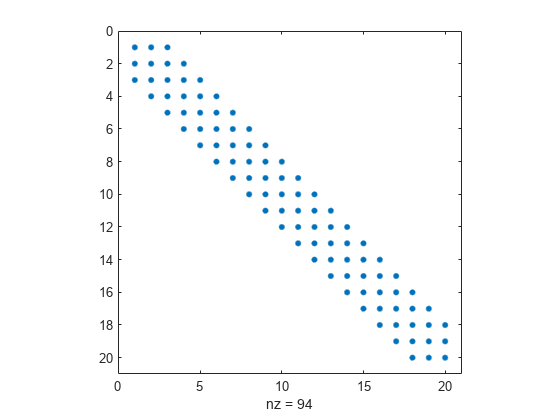範囲制約および範囲付きの前提条件子を使った最小化
この例では、fmincon trust-region-reflective アルゴリズムを使用して、範囲のある非線形問題を解く方法を説明します。このアルゴリズムは、問題がスパースである場合に効率性を高める効果があり、解析勾配、およびヘッシアンのパターンなどの既知の構造を備えています。
勾配のある目的関数
与えられた が 4 の倍数である正の数のとき、目的関数は次のようになります。
ここで、、、および です。補助関数 tbroyfg (この例の終わりに掲載) は、その勾配を含む目的関数を実装するものです。
この問題では、すべての について という範囲があります。 = 800 を使用します。
n = 800; lb = -10*ones(n,1); ub = -lb;
ヘッシアンのパターン
ヘッセ行列のスパース パターンは事前定義され、ファイル tbroyhstr.mat に保存されています。この問題のヘッシアンに関するスパース構造は、次の spy プロットのように縞模様になっています。
load tbroyhstr
spy(Hstr)
このプロットでは、中央のストライプは、5 つの縞模様の行列です。以下のプロットは、行列をより明示的に示します。
spy(Hstr(1:20,1:20))

問題のオプション
trust-region-reflective アルゴリズムを使用するためのオプションを設定します。このアルゴリズムでは、SpecifyObjectiveGradient オプションを true に設定する必要があります。
また、optimoptions を使用して HessPattern オプションを Hstr に設定してください。このような大きな問題が明らかにスパース構造をもつ場合、このオプションを設定しないと、fmincon は 64 万の非ゼロ要素をもつ完全なヘッセ行列に有限差分を使おうとするため、膨大なメモリと計算を使用します。
options = optimoptions('fmincon','SpecifyObjectiveGradient',true,'HessPattern',Hstr,... 'Algorithm','trust-region-reflective');
問題を解く
初期点として奇数インデックスに対して -1 を設定し、偶数インデックスに対して +1 を設定します。
x0 = -ones(n,1); x0(2:2:n) = 1;
この問題には線形制約または非線形制約がないため、これらのパラメーターを [] に設定します。
A = []; b = []; Aeq = []; beq = []; nonlcon = [];
fmincon を呼び出してこの問題を解きます。
[x,fval,exitflag,output] = ... fmincon(@tbroyfg,x0,A,b,Aeq,beq,lb,ub,nonlcon,options);
Local minimum possible. fmincon stopped because the final change in function value relative to its initial value is less than the value of the function tolerance. <stopping criteria details>
解および解法プロセスの検証
終了フラグ、目的関数値、1 次の最適性の尺度、およびソルバーの反復回数を検証します。
disp(exitflag);
3
disp(fval)
270.4790
disp(output.firstorderopt)
0.0163
disp(output.iterations)
7
fmincon が解に到達するまでの反復回数は、それほど多くはありません。ただし、この解は 1 次の最適性の尺度が比較的高いため、終了フラグは望ましい値である 1 ではありません。
解の改善
既定の対角型の前提条件子の代わりに、5 つの縞模様の前提条件子を使用してみてください。optimoptions を使用し、PrecondBandWidth オプションを 2 に設定して、再度問題を解きます。(帯域幅は、主対角をカウントせず、上または下対角の数です。)
options.PrecondBandWidth = 2; [x2,fval2,exitflag2,output2] = ... fmincon(@tbroyfg,x0,A,b,Aeq,beq,lb,ub,nonlcon,options);
Local minimum possible. fmincon stopped because the final change in function value relative to its initial value is less than the value of the function tolerance. <stopping criteria details>
disp(exitflag2);
3
disp(fval2)
270.4790
disp(output2.firstorderopt)
7.5340e-05
disp(output2.iterations)
9
終了フラグと目的関数値に変化は見られません。ただし、反復回数は増加し、1 次の最適性の尺度は大幅に減少します。目的関数値の差を計算します。
disp(fval2 - fval)
-2.9005e-07
目的関数値は少ししか減少していません。解が主に改善しているのは、目的関数ではなく、1 次の最適性の尺度です。
補助関数
次のコードは、tbroyfg 補助関数を作成します。
function [f,grad] = tbroyfg(x,dummy) %TBROYFG Objective function and its gradients for nonlinear minimization % with bound constraints and banded preconditioner. % Documentation example. % Copyright 1990-2008 The MathWorks, Inc. n = length(x); % n should be a multiple of 4 p = 7/3; y=zeros(n,1); i = 2:(n-1); y(i) = abs((3-2*x(i)).*x(i) - x(i-1) - x(i+1)+1).^p; y(n) = abs((3-2*x(n)).*x(n) - x(n-1)+1).^p; y(1) = abs((3-2*x(1)).*x(1) - x(2)+1).^p; j = 1:(n/2); z = zeros(length(j),1); z(j) = abs(x(j) + x(j+n/2)).^p; f = 1 + sum(y) + sum(z); % % Evaluate the gradient. if nargout > 1 g = zeros(n,1); t = zeros(n,1); i = 2:(n-1); t(i) = (3-2*x(i)).*x(i) - x(i-1) - x(i+1) + 1; g(i) = p*abs(t(i)).^(p-1).*sign(t(i)).*(3-4*x(i)); g(i-1) = g(i-1) - p*abs(t(i)).^(p-1).*sign(t(i)); g(i+1) = g(i+1) - p*abs(t(i)).^(p-1).*sign(t(i)); tt = (3-2*x(n)).*x(n) - x(n-1) + 1; g(n) = g(n) + p*abs(tt).^(p-1).*sign(tt).*(3-4*x(n)); g(n-1) = g(n-1) - p*abs(tt).^(p-1).*sign(tt); tt = (3-2*x(1)).*x(1)-x(2)+1; g(1) = g(1) + p*abs(tt).^(p-1).*sign(tt).*(3-4*x(1)); g(2) = g(2) - p*abs(tt).^(p-1).*sign(tt); j = 1:(n/2); t(j) = x(j) + x(j+n/2); g(j) = g(j) + p*abs(t(j)).^(p-1).*sign(t(j)); jj = j + (n/2); g(jj) = g(jj) + p*abs(t(j)).^(p-1).*sign(t(j)); grad = g; end end